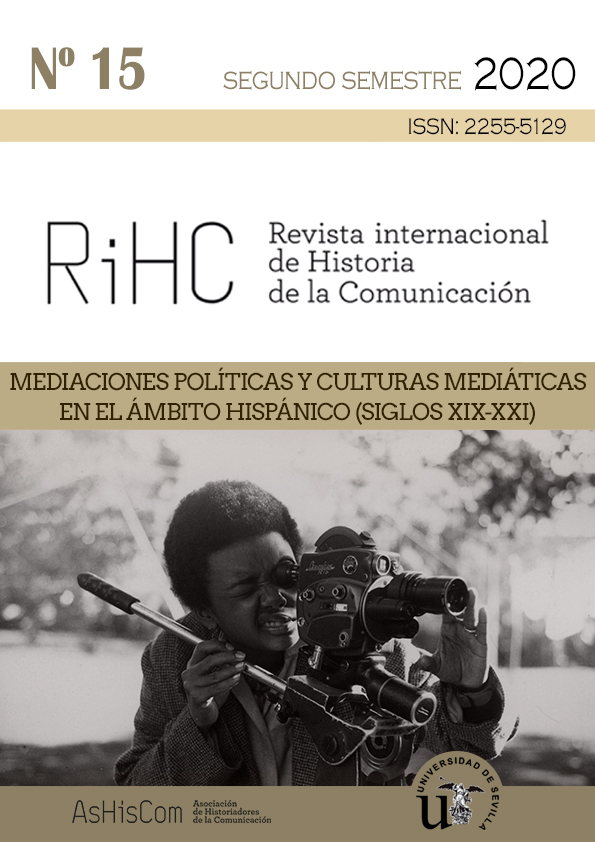Mediations of francoist violence in the XXI century Spanish movies
DOI:
https://doi.org/10.12795/RiHC.2020.i15.06Keywords:
Cine español, violencia, franquismo, mediacionesAbstract
From Butterfly’s Tongue (1999) to While at War (2019), a growing number of cinematographic fictions and documentaries depicted Franco's repression in a context of recovery of historical memory. Thus, at least forty movies from this beginning of the century allude to the maquis, prisoners and victims as a whole to denounce the violence of the dictatorship in the media. The cinema mediates memory in the public scene and tries to modify, through a plural construction, the reception of this repressive period in the collective memory. We propose to explore the evolution of the message about Franco's violence in the cinema of these last two decades, with a typology of the victims, the representations of repression and the ideological narratives that are faced in them: through cinematographic techniques and characters, as well as the use and alteration of the symbols of this violence, which place it in a moving reception area.
Downloads
References
ADORNO, T. y HORKHEIMER, M. (1998): Dialéctica de la ilustración. Fragmentos filosóficos, Madrid, Trotta.
BARRENETXEA MARAÑÓN, I. (2019): “Revenge. La violencia franquista en el cine de ficción” en Historia Actual Online, nº 49 (1), 2019, pp. 33-44.
― (2012): “Cine, represión y Memoria Histórica”, en Ibarra Aguirregabiria, A. (coordinadora), No es país para jóvenes, Vitoria, Instituto Valentín Foronda, pp. 1-20.
― (2011): “Víctimas de la represión franquista en el cine: un esencial activo del imaginario social” en Primer Congreso de Víctimas del Franquismo, 20-22 de abril de 2012, Rivas Vaciamadrid. Disponible en internet (3-12-2011): http://www.congresovictimasfranquismo.org/wp-content/uploads/2011/12/3.-Igor-Barrenetxea-V%C3%ADctimas-de-la-represi%C3%B3n-franquista-en-el-cine.pdf
BECERRA MAYOR, D. (2015): La Guerra Civil como moda literaria, Madrid, Clave Intelectual.
BETHUNE, N. y MAJADA NEILA, J. (2004): El crimen de la carretera Málaga-Almería (febrero de 1937), Benalmádena, Caligrama ediciones.
CERVERA, C. y CABANELAS, L. M. (2019): “Los 18 errores históricos de Mientras dure la guerra, la película sobre Franco y Unamuno de Amenábar” en abc.es, 29 de octubre de 2019. Disponible en internet (29-10-2019): https://www.abc.es/historia/abci-17-errores-historicos-mientras-dure-guerra-pelicula-sobre-franco-y-unamuno-amenabar-201909292254_noticia.html
CHACÓN, D. (2002): La voz dormida, Barcelona, Alfaguara.
DELAGE, A. (2019): “Javier Cercas historien. Pour une approche critique de la fiction d’archive contemporaine”, en Fabula / Les colloques, “Les écritures des archives : littérature, discipline littéraire et archives”. Disponible en internet (15-9-2019): http://www.fabula.org/colloques/document6328.php
GARCÍA, J. (2017): Cuerda de presas, Bilbao, Atisberri.
GÓMEZ BRAVO, G. (2008): La redención de penas: la formación del sistema penitenciario franquista, 1936-1950, Madrid, Catarata.
GÓMEZ RODA, J. A. (2005): “La tortura en España bajo el franquismo: testimonio de torturas durante la dictadura y la transición a la democracia” en Pasajes: Revista de pensamiento contemporáneo, nº. 17, 2005, pp. 49-67.
GOPEGUI, B. (2006): “La responsabilidad del escritor en los relatos de victoria y derrota”, IV Encuentro en Defensa de la Humanidad, Anzoátegui (Venezuela), juin 2006. Disponible en internet (11-6-2006): https://rebelion.org/la-responsabilidad-del-escritor-en-los-relatos-de-victoria-y-derrota/
GUBERN, R. y MONTERDE, J. E. (2009): Historia del cine español, Madrid, Cátedra.
HERNÁNDEZ HOLGADO, F. (2011): La prisión militante: las cárceles franquistas de mujeres de Barcelona y Madrid (1939-1945), Tesis de Doctorado, Madrid, Universidad Complutense.
LABARTHE, J. (2006): L’épopée, París, Armand Colin.
LIPOVETSKY, G. y SERROY, J. (2009): La pantalla global. Cultura mediática y cine en la era hipermoderna, Barcelona, Anagrama.
MARTÍNEZ ÁLVAREZ, J. (2012): “Las películas sobre el maquis español: de la historia oficial a la memoria histórica” en Cuadernos de Historia Contemporánea, nº 34, 2012, pp. 225-250.
NÚÑEZ, G. (2019): “La Plataforma Millán-Astray denuncia mentiras y odio en la nueva película de Amenábar” en larazon.es, 14 de junio de 2019. Disponible en internet (14-6-2019): https://www.larazon.es/cultura/la-plataforma-millan-astray-denuncia-mentiras-y-odio-en-la-nueva-pelicula-de-amenabar-PO23787585/
OCAÑA, J. (2016): “La superficie de la tragedia” en elpais.com, 9 de septiembre de 2016. Disponible en internet (9-9-2016): https://elpais.com/cultura/2016/09/07/actualidad/1473260767_410625.html
PIÑA, B. (2019): “Alejandro Amenábar: No estoy a la misma distancia de Unamuno que de Franco, pero quería ser justo y no cargar las tintas” en publico.es, 27 de septiembre de 2019. Disponible en internet (27-9-2019): https://www.publico.es/culturas/dure-guerra-alejandro-amenabar-no-distancia-unamuno-franco-queria-justo-no-cargar-tintas.html
SÁNCHEZ NORIEGA, J. L. (2016): “La prisión, espacio cinematográfico y lugar de memoria en el cine español” en Cuadernos de Historia Contemporánea, nº 38, 2016, pp. 303-323.
TRENZADO ROMERO, M. (2000): “El cine desde la perspectiva de la Ciencia Política” en REIS: Revista Española de Investigaciones Sociológicas, nº 92, 2000, pp. 45-70.
Published
Versions
- 2021-01-12 (3)
- 2021-01-12 (2)
- 2021-01-07 (1)
How to Cite
Issue
Section
License
Copyright (c) 2021 RIHC. Revista Internacional de Historia de la Comunicación

This work is licensed under a Creative Commons Attribution-NonCommercial-ShareAlike 4.0 International License.
RiHC. Revista internacional de Historia de la Comunicación is an open access publication, offering its content under the principle that making research available to the public free of charge contributes to the greater exchange of global knowledge.
RiHC. Revista internacional de Historia de la Comunicación adheres to the various initiatives that promote access to knowledge. All content is therefore free of charge and is published under the Creative Commons Attribution-NonCommercial-ShareAlike 4.0 International license.
By virtue of this, the authors who publish in this journal accept the following conditions:
- Open access content may be freely shared (that is, copied and redistributed in any medium or format) and adapted (remixed, transformed and built upon).
- Attribution: The user of the content must give appropriate credit, provide a link to the license, and indicate if changes were made. This may be done in any reasonable manner, but not in any way that suggests the licensor endorses the user or their use.
- Non Commercial: The content may not be used for any commercial purpose.
- Share Alike: If the content is remixed, transformed or built upon, it must be distributed under the same licence as the original.
- No additional restrictions: No legal terms or technological measures may be applied that legally restrict others from doing anything the licence permits.
Accepted 2020-11-22
Published 2021-01-12
- Abstract 384




